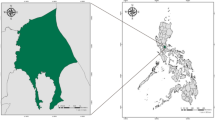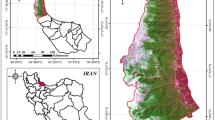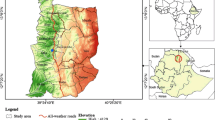Abstract
The purpose of this study, covering the northern Ulus district of Turkey, was to analyze the forest and land use/land cover (LULC) changes in the past period from 2000 to 2020, and to predict the possible changes in 2030 and 2040, using remote sensing (RS) and geographic information systems (GIS) together with the CA–Markov model. The maximum likelihood classified (MLC) technique was used to produce LULC maps, using 2000 and 2010 Landsat (ETM +) and 2020 Landsat (OLI) images based on existing stand-type maps as reference. Using the historical data from the generated LULC maps, the LULC changes for 2030–2040 were predicted via the CA-Markov hybrid model. The reliability of the model was verified by overlap** the 2020 LULC map with the 2020 LULC model (predicted) map. The overall accuracy was found to be 80.90%, with a Kappa coefficient of 0.74. The total forest area (coniferous + broad-leaved + mixed forest) grew by 10,656.4 ha (15.4%) in the 2000–2020 period. Examination of the types within the Forest Class revealed that the coniferous forest area had grown by 5.9% in the period 2000–2010, whereas it had decreased by 4.7% in the period 2010–2020. The broad-leaved forest area had grown by 1.2% and 3.1%, respectively, between 2000 and 2010 and 2010 and 2020. The mixed forest area had been reduced by 7.1% in the period 2000–2010 but had grown by 1.7% in the 2010–2020 period. In the Non-Forest Class, although the water area had increased in the 2000–2020 period, agricultural land and settlement areas had decreased by 11,553.9 ha (32.3%) and 34.6 ha (0.5%), respectively. According to the 2020–2040 LULC simulation results, it was predicted that there would be 3.8% and 26.4% growth in the total forest and water surface areas and 13.9% and 5.3% reduction in the agricultural and settlement areas, respectively. Using the LULC simulation to separate the Forest Class into coniferous, broad-leaved, and mixed forest categories and subsequently examining the individual changes can be of great help to forest planners and managers in decision-making and strategy development.









Similar content being viewed by others
Data availability
All data generated or analyzed during this study are included in this published article (and its supplementary information files).
References
Aburas, M. M., Ho, Y. M., Pradhan, B., Salleh, A. H., & Alazaiza, M. Y. (2021). Spatio-temporal simulation of future urban growth trends using an integrated CA-Markov model. Arabian Journal of Geosciences, 14(2), 1–12. https://doi.org/10.1007/s12517-021-06487-8
Adhikari, R. N., Rao, M. S. R. M., Selvi, V., Math, S. K. N., Husenappa, V., Chandrappa, M., & Reddy, K. K. (2002). Studies on runoff coefficient of rational formula. Indian Journal of Soil Conservation, 30(1), 106–108.
Akinyemi, F. O. (2017). Land change in the central Albertine rift: Insights from analysis and map** of land use-land cover change in north-western Rwanda. Applied Geography, 87, 127–138. https://doi.org/10.1016/j.apgeog.2017.07.016
Akinyemi, F. O., Pontius, R. G., Jr., & Braimoh, A. K. (2017). Land change dynamics: Insights from Intensity Analysis applied to an African emerging city. Journal of Spatial Science, 62(1), 69–83. https://doi.org/10.1080/14498596.2016.1196624
Aksoy, H., & Kaptan, S. (2020). Simulation of future forest and land use/cover changes (2019–2039) using the cellular automata-Markov model. Geocarto International, 1-20. https://doi.org/10.1080/10106049.2020.1778102
Anon. (2020). Bartın Valiliği Web Sayfası. http://www.bartin.gov.tr
Atik, S. (1998). Bartın İl Turizm Envanteri ve Turizmi Geliştirme Planı Açıklama Raporu. Bartın Valiliği, Bartın, 150 s.
Ball, G. L. (1994). Ecosystem modeling with GIS. Environmental Management, 18(3), 345–349. https://doi.org/10.1007/BF02393865
Başkent, E. Z., & Kadioğullari, A. I. (2007). Spatial and temporal dynamics of land use pattern in Turkey: A case study in İnegöl. Landscape and Urban Planning, 81(4), 316–327. https://doi.org/10.1016/j.landurbplan.2007.01.007
Bayar, R. (2018). Arazi kullanımı açısından Türkiye’de tarım alanlarının değişimi. Coğrafi Bilimler Dergisi, 16(2), 187–200.
Bozali, N., Sivrikaya, F. & Akay, A.E. (2015). Use of spatial pattern analysis to assess forest cover changes in the Mediterranean region of Turkey. Journal of Forest Research, 20, 365–374. https://doi.org/10.1007/s10310-015-0493-2
Bozkaya, A. G., Balcik, F. B., Goksel, C., & Esbah, H. (2015). Forecasting land-cover growth using remotely sensed data: A case study of the Igneada protection area in Turkey. Environmental Monitoring and Assessment, 187(3), 1–18. https://doi.org/10.1007/s10661-015-4322-z
Carpenter, S. R., Mooney, H. A., Agard, J., Capistrano, D., DeFries, R. S., Díaz, S., Dietz, T., Duraiappah, A. K., Oteng-Yeboah, A. A., Perrings, C., Reid, W. V., Sarukhan, J., Pereira, H. M., Scholes, R. J., & Whyte, A. (2009). Science for managing ecosystem services: Beyond the Millennium Ecosystem Assessment. Proceedings of the National Academy of Sciences, 106(5), 1305–1312. https://doi.org/10.1073/pnas.0808772106
Congalton, R. G. (2001). Accuracy assessment and validation of remotely sensed and other spatial information. International Journal of Wildland Fire, 10(4), 321–328. https://doi.org/10.1071/WF01031
Congalton, R. G., Green, K. (2019). Assessing the accuracy of remotely sensed data: principles and practices (3rd Ed.). CRC press
Çakir, G., Sivrikaya, F., & Keleş, S. (2008). Forest cover change and fragmentation using Landsat data in Macka state forest enterprise in Turkey. Environmental Monitoring and Assessment, 137(1–3), 51–66. https://doi.org/10.1007/s10661-007-9728-9
da Cunha, E. R., Santos, C. A. G., da Silva, R. M., Bacani, V. M., & Pott, A. (2021). Future scenarios based on a CA-Markov land use and land cover simulation model for a tropical humid basin in the Cerrado/Atlantic forest ecotone of Brazil. Land Use Policy, 101, 105141. https://doi.org/10.1016/j.landusepol.2020.105141
Degife, A. W., Zabel, F., & Mauser, W. (2018). Assessing land use and land cover changes and agricultural farmland expansions in Gambella Region Ethiopia using Landsat 5 and Sentinel 2a multispectral data. Heliyon, 4(11), e00919. https://doi.org/10.1016/j.heliyon.2018.e00919
Feng, Y., Cai, Z., Tong, X., Wang, J., Gao, C., Chen, S., & Lei, Z. (2018). Urban growth modeling and future scenario projection using cellular automata (CA) models and the R Package Optimx. ISPRS International Journal of Geo-Information, 7(10), 387. https://doi.org/10.3390/ijgi7100387
Feng, Y., Lei, Z., Tong, X., Gao, C., Chen, S., Wang, J., & Wang, S. (2020). Spatially-explicit modeling and intensity analysis of China’s land use change 2000–2050. Journal of Environmental Management, 263, 110407. https://doi.org/10.1016/j.jenvman.2020.110407
Fiquepron, J., Garcia, S., & Stenger, A. (2013). Land use impact on water quality: Valuing forest services in terms of the water supply sector. Journal of Environmental Management, 126, 113–121. https://doi.org/10.1016/j.jenvman.2013.04.002
Gharbia, S. S., Abd Alfatah, S., Gill, L., Johnston, P., & Pilla, F. (2016). Land use scenarios and projections simulation using an integrated GIS cellular automata algorithms. Modeling Earth Systems and Environment, 2(3), 1–20. https://doi.org/10.1007/s40808-016-0210-y
Gómez, C., White, J. C., & Wulder, M. A. (2016). Optical remotely sensed time series data for land cover classification: A review. ISPRS Journal of Photogrammetry and Remote Sensing, 116, 55–72. https://doi.org/10.1016/j.isprsjprs.2016.03.008
Guan, D., Gao, W., Watari, K., & Fukahori, H. (2008). Land use change of Kitakyushu based on landscape ecology and Markov model. Journal of Geographical Sciences, 18(4), 455–468. https://doi.org/10.1007/s11442-008-0455-0
Günşen, H. B. (2012). Orman köylerinde iç göçleri etkileyen faktörler (Bartın-Kastamonu Örneği). Bartın Üniversitesi Fen Bilimleri Enstitüsü Doktora Tezi.
Hou, H., Wang, R., & Murayama, Y. (2019). Scenario-based modelling for urban sustainability focusing on changes in cropland under rapid urbanization: A case study of Hangzhou from 1990 to 2035. Science of the Total Environment, 661, 422–431. https://doi.org/10.1016/j.scitotenv.2019.01.208
Huang, Y., Yang, B., Wang, M., Liu, B., & Yang, X. (2020). Analysis of the future land cover change in Bei**g using CA–Markov chain model. Environmental Earth Sciences, 79(2), 1–12. https://doi.org/10.1007/s12665-019-8785-z
Itami, R. M. (1994). Simulating spatial dynamics: Cellular automata theory. Landscape and Urban Planning, 30(1–2), 27–47. https://doi.org/10.1016/0169-2046(94)90065-5
Kadioğullari, A. İ, Keleş, S., Başkent, E. Z., & Günlü, A. (2008). Spatiotemporal changes in landscape pattern in response to aforestation in Northeastern Turkey: a case study of Torul. Scottish Geographical Journal, 124(4), 259–273. https://doi.org/10.1080/14702540802566254
Kadioğullari, A. İ, Sayin, M. A., Çelįk, D. A., Borucu, S., Çįl, B., & Bulut, S. (2014). Analysing land cover changes for understanding of forest dynamics using temporal forest management plans. Environmental Monitoring and Assessment, 186(4), 2089–2110.
Kamusoko, C., Aniya, M., Adi, B., & Manjoro, M. (2009). Rural sustainability under threat in Zimbabwe–simulation of future land use/cover changes in the Bindura district based on the Markov-cellular automata model. Applied Geography, 29(3), 435–447. https://doi.org/10.1016/j.apgeog.2008.10.002
Kaptan, S. (2018). Sosyo-Ekonomik Durum Envanteri ve Orman Amenajman Planlarına Yansıtılması. Doktora Tezi Bartın Üniversitesi Fen Bilimleri Enstitüsü
Kaptan, S. (2021a). Changes in forest areas and land cover and their causes using ıntensity analysis: The case of Alabarda Forest Planning Unit. Environmental Monitoring and Assessment, 193(7), 1–17. https://doi.org/10.1007/s10661-021-09089-9
Kaptan, S. (2021b). Arazi örtüsü ile meşcere gelişim çağı ve kapalılığı kategorilerindeki zamansal değişimlerin incelenmesi: Karabiga Orman İşletme Şefliği örneği. Turkish Journal of Forestry, 22(2), 97-104. https://doi.org/10.18182/tjf.903733
Kaptan, S., Aksoy, H., Durkaya, B., Aksoy, Ş. Ç. (2019). Coğrafi bilgi sistemleri ile arazi örtüsü ve kullanımında yaşanan değişimlerin incelenmesi (Akgöl orman işletme şefliği örneği). 8th International Vocational Schools Symposium.
Kaptan, S., & Durkaya, A. (2019). Analysing temporal and spatial changes in land cover: the case of Drahna Forest Subdistrict Directorate. Kastamonu University Journal of Forestry Faculty, 19(1), 47–56. https://doi.org/10.17475/kastorman.543428
Karki, S., Thandar, A. M., Uddin, K., Tun, S., Aye, W. M., Aryal, K., Kandel, P., & Chettri, N. (2018). Impact of land use land cover change on ecosystem services: A comparative analysis on observed data and people’s perception in Inle Lake Myanmar. Environmental Systems Research, 7(1), 1–15. https://doi.org/10.1186/s40068-018-0128-7
Keshtkar, H., & Voigt, W. (2016). Potential impacts of climate and landscape fragmentation changes on plant distributions: Coupling multi-temporal satellite imagery with GIS-based cellular automata model. Ecological Informatics, 32, 145–155. https://doi.org/10.1016/j.ecoinf.2016.02.002
Keshtkar, H., Voigt, W., & Alizadeh, E. (2017). Land-cover classification and analysis of change using machine-learning classifiers and multi-temporal remote sensing imagery. Arabian Journal of Geosciences, 10, 154. https://doi.org/10.1007/s12517-017-2899-y
Khawaldah, H. A., Farhan, I., & Alzboun, N. M. (2020). Simulation and prediction of land use and land cover change using GIS, remote sensing and CA-Markov model. Global Journal of Environmental Science and Management, 6(2), 215–232. https://doi.org/10.22034/GJESM.2020.02.07
Khwarahm, N. R. (2021). Spatial modeling of land use and land cover change in Sulaimani, Iraq, using multitemporal satellite data. Environmental Monitoring and Assessment, 193(3), 1–18. https://doi.org/10.1007/s10661-021-08959-6
Khwarahm, N. R., Qader, S., Ararat, K., & Al-Quraishi, A. M. F. (2020). Predicting and map** land cover/land use changes in Erbil/Iraq using CA-Markov synergy model. Earth Science Informatics, 1-14. https://doi.org/10.1007/s12145-020-00541-x
Li, W., Dong, R., Fu, H., Wang, J., Yu, L., & Gong, P. (2020). Integrating Google Earth imagery with Landsat data to improve 30-m resolution land cover map**. Remote Sensing of Environment, 237, 111563. https://doi.org/10.1016/j.rse.2019.111563
Mansour, S., Al-Belushi, M., & Al-Awadhi, T. (2020). Monitoring land use and land cover changes in the mountainous cities of Oman using GIS and CA-Markov modelling techniques. Land Use Policy, 91, 104414. https://doi.org/10.1016/j.landusepol.2019.104414
Mondal, M. S., Sharma, N., Garg, P. K., & Kappas, M. (2016). Statistical independence test and validation of CA Markov land use land cover (LULC) prediction results. The Egyptian Journal of Remote Sensing and Space Science, 19(2), 259–272. https://doi.org/10.1016/j.ejrs.2016.08.001
Moradi, F., Kaboli, H. S., & Lashkarara, B. (2020). Projection of future land use/cover change in the Izeh-Pyon Plain of Iran using CA-Markov model. Arabian Journal of Geosciences, 13(19), 1–17. https://doi.org/10.1007/s12517-020-05984-6
Motlagh, Z. K., Lotfi, A., Pourmanafi, S., Ahmadizadeh, S., & Soffianian, A. (2020). Spatial modeling of land-use change in a rapidly urbanizing landscape in central Iran: Integration of remote sensing, CA-Markov, and landscape metrics. Environmental Monitoring and Assessment, 192(11), 1–19. https://doi.org/10.1007/s10661-020-08647-x
Munthali, M. G., Mustak, S., Adeola, A., Botai, J., Singh, S. K., & Davis, N. (2020). Modelling land use and land cover dynamics of Dedza district of Malawi using hybrid Cellular Automata and Markov model. Remote Sensing Applications: Society and Environment, 17, 100276. https://doi.org/10.1016/j.rsase.2019.100276
Naboureh, A., Moghaddam, M. H. R., Feizizadeh, B., & Blaschke, T. (2017). An integrated object-based image analysis and CA-Markov model approach for modeling land use/land cover trends in the Sarab plain. Arabian Journal of Geosciences, 10(12), 1–16. https://doi.org/10.1007/s12517-017-3012-2
Niya, A. K., Huang, J., Kazemzadeh-Zow, A., Karimi, H., Keshtkar, H., & Naimi, B. (2020). Comparison of three hybrid models to simulate land use changes: A case study in Qeshm Island Iran. Environmental Monitoring and Assessment, 192(5), 1–19. https://doi.org/10.1007/s10661-020-08274-6
Pflugmacher, D., Rabe, A., Peters, M., & Hostert, P. (2019). Map** pan-European land cover using Landsat spectral-temporal metrics and the European LUCAS survey. Remote Sensing of Environment, 221, 583–595. https://doi.org/10.1016/j.rse.2018.12.001
Reddy, C. S., Saranya, K. R. L., Pasha, S. V., Satish, K. V., Jha, C. S., Diwakar, P. G., Dadhwal, V. K., Rao, P. V. N., & Murthy, Y. K. (2018). Assessment and monitoring of deforestation and forest fragmentation in South Asia since the 1930s. Global and Planetary Change, 161, 132–148. https://doi.org/10.1016/j.gloplacha.2017.10.007
Reis, M., Dutal, H., Abız, B., & Bolat, N. (2016). Kahramanmaraş ili Göksun ilçesinde arazi kullanımında meydana gelen zamansal değişimin uzaktan algılama teknikleri ve coğrafi bilgi sistemi ile belirlenmesi. Kahramanmaraş Sütçü İmam Üniversitesi Mühendislik Bilimleri Dergisi, 19(2), 35–41. https://doi.org/10.17780/ksujes.91496
Ren, Y., Lü, Y., Comber, A., Fu, B., Harris, P., & Wu, L. (2019). Spatially explicit simulation of land use/land cover changes: Current coverage and future prospects. Earth-Science Reviews, 190, 398–415. https://doi.org/10.1016/j.earscirev.2019.01.001
Rimal, B., Keshtkar, H., Sharma, R., Stork, N., Rijal, S., & Kunwar, R. (2019). Simulating urban expansion in a rapidly changing landscape in eastern Tarai Nepal. Environmental Monitoring and Assessment, 191(4), 1–14. https://doi.org/10.1007/s10661-019-7389-0
Rohde, K. (Ed.). (2013). The Balance of Nature and Human Impact. Cambridge University Press.
Ruben, G. B., Zhang, K., Dong, Z., & **a, J. (2020). Analysis and projection of land-use/land-cover dynamics through scenario-based simulations using the CA-Markov model: A case study in Guanting Reservoir Basin China. Sustainability, 12(9), 3747. https://doi.org/10.3390/su12093747
Salem, M., Tsurusaki, N., & Divigalpitiya, P. (2020). Land use/land cover change detection and urban sprawl in the peri-urban area of greater Cairo since the Egyptian revolution of 2011. Journal of Land Use Science, 15(5), 592–606. https://doi.org/10.1080/1747423X.2020.1765425
Sang, L., Zhang, C., Yang, J., Zhu, D., & Yun, W. (2011). Simulation of land use spatial pattern of towns and villages based on CA–Markov model. Mathematical and Computer Modelling, 54(3–4), 938–943. https://doi.org/10.1016/j.mcm.2010.11.019
Schulp, C. J., Nabuurs, G. J., & Verburg, P. H. (2008). Future carbon sequestration in Europe—effects of land use change. Agriculture, Ecosystems & Environment, 127(3–4), 251–264. https://doi.org/10.1016/j.agee.2008.04.010
Sikka, A. K., & Selvi, V. (2005). Experimental examination of rational runoff coefficient for small agricultural and forest watersheds in the Nilgiris. IE (I) Journal—AG.
Singh, S. K., Mustak, S., Srivastava, P. K., Szabó, S., & Islam, T. (2015). Predicting spatial and decadal LULC changes through cellular automata Markov chain models using earth observation datasets and geo-information. Environmental Processes, 2(1), 61–78. https://doi.org/10.1007/s40710-015-0062-x
Sivrikaya, F., Çakır, G., Kadioğullari, A., Keleş, S., Başkent, E. Z., & Terzioğlu, S. (2007). Evaluating land use/land cover changes and fragmentation in the Camili forest planning unit of northeastern Turkey from 1972 to 2005. Land Degradation & Development, 18(4), 383–396. https://doi.org/10.1002/ldr.782
Snedecor, G., & Cochran, W. (1969). Statistical methods 6th ed The Iowa State University Press Ames lowa USA.
Steffen, W., Sanderson, R. A., Tyson, P. D., Jäger, J., Matson, P. A., Moore III, B., Oldfield, F., Richardson, K., Schellnhuber, H. J., Turner, B. L., & Wasson, R. J. (2006). Global change and the earth system: a planet under pressure. Springer Science & Business Media.
Tolessa, T., Senbeta, F., & Kidane, M. (2017). The impact of land use/land cover change on ecosystem services in the central highlands of Ethiopia. Ecosystem Services, 23, 47–54. https://doi.org/10.1016/j.ecoser.2016.11.010
USGS, (2020). United States Geological Survey Landsat Missions Landsat 8. Accessed November 06, 2020, from https://www.usgs.gov/
Verburg, P. H., & Overmars, K. P. (2009). Combining top-down and bottom-up dynamics in land use modeling: Exploring the future of abandoned farmlands in Europe with the Dyna-CLUE model. Landscape Ecology, 24(9), 1167–1181. https://doi.org/10.1007/s10980-009-9355-7
Wang, R., & Murayama, Y. (2017). Change of land use/cover in Tian** city based on the markov and cellular automata models. ISPRS International Journal of Geo-Information, 6(5), 150. https://doi.org/10.3390/ijgi6050150
Wang, Y., & Zhang, X. (2001). A dynamic modeling approach to simulating socioeconomic effects on landscape changes. Ecological Modelling, 140(1–2), 141–162. https://doi.org/10.1016/S0304-3800(01)00262-9
Weng, Q. (2002). Land use change analysis in the Zhujiang Delta of China using satellite remote sensing GIS and stochastic modelling. Journal of Environmental Management, 64(3), 273–284. https://doi.org/10.1006/jema.2001.0509
Wolfram, S. (1984). Cellular automata as models of complexity. Nature, 311(5985), 419–424. https://doi.org/10.1038/311419a0
Wu, X., Shen, Z., Liu, R., & Ding, X. (2008). Land use/cover dynamics in response to changes in environmental and socio-political forces in the upper reaches of Yangtze River China. Sensors, 8(12), 8104–8122. https://doi.org/10.3390/s8128104
Xu, T., Gao, J., & Coco, G. (2019). Simulation of urban expansion via integrating artificial neural network with Markov chain–cellular automata. International Journal of Geographical Information Science, 33(10), 1960–1983. https://doi.org/10.1080/13658816.2019.1600701
Yang, Y., Zhang, S., Yang, J., **ng, X., & Wang, D. (2015). Using a cellular automata-Markov model to reconstruct spatial land-use patterns in Zhenlai County northeast China. Energies, 8(5), 3882–3902. https://doi.org/10.3390/en8053882
Zadbagher, E., Becek, K., & Berberoglu, S. (2018). Modeling land use/land cover change using remote sensing and geographic information systems: Case study of the Seyhan Basin Turkey. Environmental Monitoring and Assessment, 190(8), 1–15. https://doi.org/10.1007/s10661-018-6877-y
Zhu, Z., & Woodcock, C. E. (2014). Continuous change detection and classification of land cover using all available Landsat data. Remote Sensing of Environment, 144, 152–171. https://doi.org/10.1016/j.rse.2014.01.011
Acknowledgements
We would like to thank the General Directorate of Forestry (Orman Genel Müdürlüğü—OGM), the Zonguldak Regional Directorate of Forestry, and the Ulus Directorate of Forest Operations and their staff for supplying and delivering the forest cover–type maps and forest management plans.
Author information
Authors and Affiliations
Corresponding author
Additional information
Publisher's Note
Springer Nature remains neutral with regard to jurisdictional claims in published maps and institutional affiliations.
Rights and permissions
About this article
Cite this article
Aksoy, H., Kaptan, S. Monitoring of land use/land cover changes using GIS and CA-Markov modeling techniques: a study in Northern Turkey. Environ Monit Assess 193, 507 (2021). https://doi.org/10.1007/s10661-021-09281-x
Received:
Accepted:
Published:
DOI: https://doi.org/10.1007/s10661-021-09281-x




